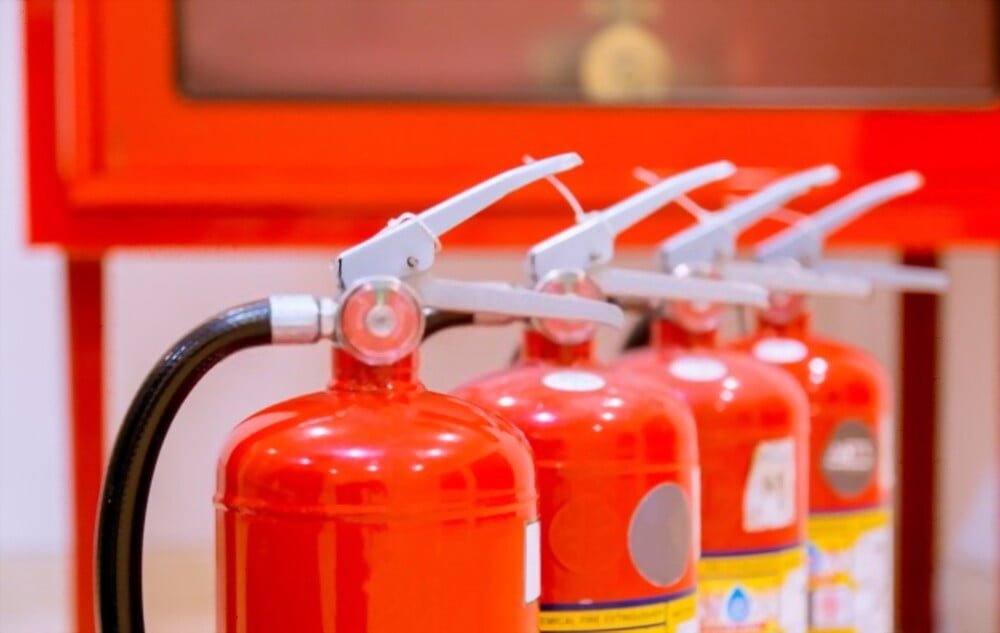Fire extinguisher types: what are they, and what are their details?
The finest types of fire extinguishers are filled with organic materials and chemical components, resulting in foam used to extinguish fires caused by the combustion of liquid materials such as oil, petroleum, and alcohol. They insulate the fire from oxygen and cool it with water; they cannot be used with fires caused by electricity. Foam fire extinguishers come in two types:
-
Chemical Foam Fire Extinguishers:
The foam is produced by a chemical reaction of various chemicals such as fluoroprotein, petrosal, and cosil. They are supplemented with materials that help them withstand shocks.
-
Mechanical Foam Fire Extinguishers:
The foam is produced by mixing foam liquid with water and air, with the foam being pressurized by carbon dioxide gas.
Properties of foam fire extinguishers:
- Adhesion property to vertical and horizontal surfaces.
- Heat resistance to prevent the bubbles from bursting due to heat.
- Bubble cohesion strength to prevent them from breaking from air or water.
- Sliding property over the surface of the ignited liquid and preventing air from reaching it.
- Powder fire extinguishers:
Multi-purpose fire extinguishers are used to extinguish fires caused by wood, paper, and textiles, as well as fires caused by flammable liquids and gases.
This type of extinguisher produces a powder that can cause visibility impairment, so caution must be exercised when using it.
It comes in various types and forms, including:
-
Wet chemical fire extinguisher:
Fire extinguishers filled with liquid chemical organic substances used effectively to extinguish cooking oil fires.
-
Dry powder fire extinguishers:
Fire extinguishers filled with dry chemical powder, such as sodium bicarbonate or calcium carbonate. The cylinder is pressurized with nitrogen gas. They are used to extinguish all types of fires by isolating the fire from the surrounding oxygen. This includes fires caused by burning petroleum and flammable metals like sodium, potassium, and magnesium.
CO2 fire extinguishers are filled with carbon dioxide gas, which transforms into a liquid under high pressure. It works by isolating the burning area from oxygen and helping to reduce the temperature. The cooling value is estimated to be around “60-110” heat units.
It is characterized by its rapid spread and its non-conductivity to electricity. A CO2 fire extinguisher is used to extinguish fires caused by igniting liquid petroleum substances or electrical fires. However, they are not suitable for fires involving sensitive electronic devices. It is important to use this type of extinguisher in areas far from air currents to prevent the poisoning or suffocation of individuals, as it can cause a loss of visibility.
The halon fire extinguisher is a type of handheld fire extinguisher used to quickly extinguish and suppress all types of fires. However, its frequent use is not recommended, especially in enclosed spaces, because the vapor it produces contains chlorine, fluorine, and bromine compounds that are harmful to the ozone layer. However, it does not cause harm if not inhaled in large quantities.
How to use a Halon fire extinguisher?
- The halon fire extinguisher should be directed towards the nearest end of the fire in the case of fires involving flammable liquids.
- The halon fire extinguisher should be aimed downward at the base of the fire and moved upward if the burning liquid is cascading from above.
- The halon fire extinguisher should be aimed directly at the fire in a straight line if the fire is caused by an electrical contact.
-
Water fire extinguisher:
A water fire extinguisher is a pressurized fire extinguisher filled with ordinary water. It is used to extinguish ordinary fires but cannot be used for fires caused by electrical contact. In the case of electrical fires, water will not extinguish the fire but rather increase its spread.
